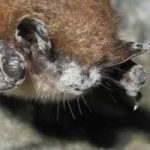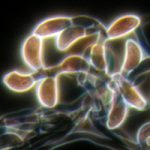White-nose syndrome of bats
Published: June 11th, 2010
Revised: March 7th, 2015
 White-nose syndrome (WNS) is a grave new disease of overwintering bats that has stricken bats throughout North America over the last few years. WNS is caused by a newly-described fungus, Pseudogymnoascus destructans, first discovered in New York state in 2006. It has so far been found in 11 states and 2 Canadian provinces. The affected bat pictured here was from a Massachusetts (photo by Dr. Jeremy Coleman, US Fish & Wildlife Service)
White-nose syndrome (WNS) is a grave new disease of overwintering bats that has stricken bats throughout North America over the last few years. WNS is caused by a newly-described fungus, Pseudogymnoascus destructans, first discovered in New York state in 2006. It has so far been found in 11 states and 2 Canadian provinces. The affected bat pictured here was from a Massachusetts (photo by Dr. Jeremy Coleman, US Fish & Wildlife Service)
Bats affected by WNS develop a whitish discoloration on their noses and wings consisting of fungal mycelium emerging from the bat’s skin resulting ultimately in mortality of the affected animal. A wide range of ecologically beneficial bat species are affected. In addition to consuming mosquitoes, many bat species are important predators of night-flying insects such as moths which may be agricultural pests.
 Pseudogymnoascus destructans is a mould that produces densely branched, curving chains of bean-shaped spores. This photo shows a microscopic mount from a 7 day old colony grown on Potato Dextrose agar prepared by our colleague Professor Kathie Hodge from Cornell University in Ithaca, New York. The fungus does not appear to present an infectious hazard to humans or other animals apart from bats. In bats, the transmission of P. destructans is believed to transmitted by contact; however, it is unknown if the fungus affects only unhealthy bats or if it can infect normal, healthy animals. Although unproven, it is possible that the fungus may “hitchhike” from cave-to-cave on clothing and footwear of inadvertent spelunkers.
Pseudogymnoascus destructans is a mould that produces densely branched, curving chains of bean-shaped spores. This photo shows a microscopic mount from a 7 day old colony grown on Potato Dextrose agar prepared by our colleague Professor Kathie Hodge from Cornell University in Ithaca, New York. The fungus does not appear to present an infectious hazard to humans or other animals apart from bats. In bats, the transmission of P. destructans is believed to transmitted by contact; however, it is unknown if the fungus affects only unhealthy bats or if it can infect normal, healthy animals. Although unproven, it is possible that the fungus may “hitchhike” from cave-to-cave on clothing and footwear of inadvertent spelunkers.
Dr. Scott is currently part of a volunteer scientific advisory panel on WNS led by scientists at the US Geological Service. Both Dr. Scott and Dr. Summerbell have published extensively on the fungal group to which P. destructans belongs. Our expertise on this agent uniquely positions us to provide authoritative consultation on this new and devastating pathogen.




